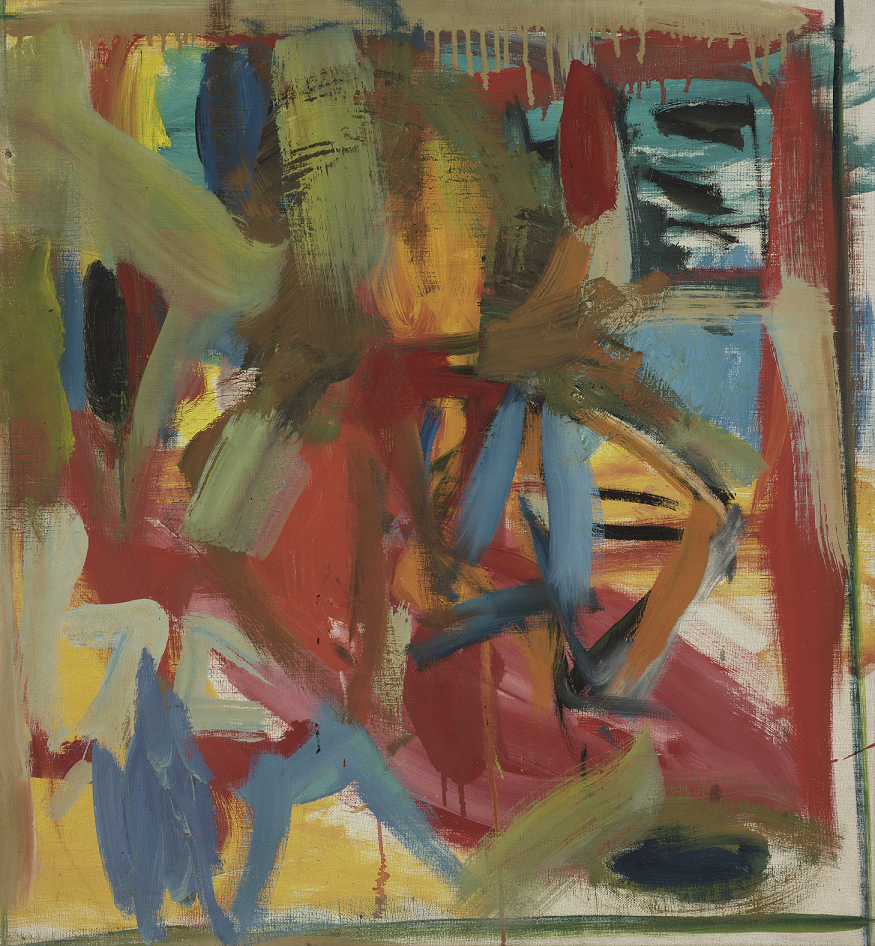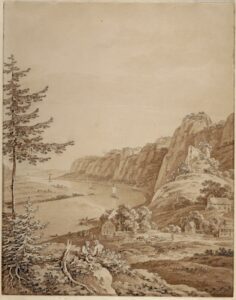Today’s post comes from Angela Brown, class of 2016 and Art Center Student Docent.
Hanging side by side, Man in a Whirl by Elaine de Kooning and Black and White Rome F by Willem de Kooning seem to be very different characters in the same complex story. One could say that this “story” is that of abstract expressionism itself. This was a movement focused on the process of creating art unconcerned with preconceived rules or functions. Art was a channeling of the subconscious, a synthesis of the artist’s ideas, impressions, and instincts.
Man in a Whirl and Black and White Rome F both have a strong, expressive quality which ignites human reaction and even empathy. However, they communicate this expressiveness in quite different ways. No two artists (or, no two people in general) communicate their impressions in the same way, but they do inspire and draw from each other.
Elaine de Kooning and Willem de Kooning are prime examples of how artists develop via the amalgamation of their present state, past experiences, and exposure to other people/artists. The couple met in 1938 and, within a year, Elaine had already roused a pivotal change in Willem’s oeuvre. With Elaine often posing as his model, Willem began his first woman series, a refreshing departure from his former work which was usually dominated by the male form.
In the years succeeding their wedding in December of 1943, Willem and Elaine grew apart, pursuing separate interests and creating different paths for themselves. Elaine went to Provincetown for a while and Willem began to paint his signature black and white paintings, establishing himself as an abstract expressionist. In the summer of 1948, the couple reunited at Black Mountain College in North Carolina where Willem was invited to teach by artist Josef Albers. Elaine and Willem reacted very differently to this new environment. As a New Yorker, Willem was overwhelmed by the vastness and heaviness of the sky. He didn’t want to see the universe in this way, but it did change his perspective. According to Elaine, he began using colored pastels in North Carolina. In his New York studio, Willem was surrounded by his previous work and felt an obligation to maintain some sort of continuity (black and white). However, he didn’t feel compelled to follow his old habits while in North Carolina. Elaine remained in North Carolina even after Willem left. She worked with such influential artists as John Cage and Merce Cunningham and began writing critiques for ArtNews.
In 1957, when Elaine de Kooning painted Man in a Whirl, she was in Albuquerque teaching at the University of New Mexico. The composition and abstraction of the work allude to outside factors which affected Willem also: the post-war temper of the time, various New York school artists, and existentialism. The painting’s warm colors echo those of the American southwest; this shows the influence of the artist’s location.
Black and White Rome F, on the other hand, was painted by Willem de Kooning in 1959. The artist was staying with Beat Generation poet Greg Corso in Rome. Corso recalls having a grand time with de Kooning, but noticed that Willem was “unhappy about love.” This “unhappiness”—which could probably be better described as discontent/confusion—is communicated in both the process and final products of Willem’s Black and White Rome series. De Kooning would mix black oil or enamel with pumice to thicken it and reduce its sheen. Then, he would apply this medium to both sides of the paper on the floor using a housepainter’s brush, rip the paper, and rearrange the segments into new compositions. This rearranging engenders a certain tension in Black and White Rome F in particular because the bold brush strokes draw the eye across the page and cause the viewer to expect a certain conclusion: a shape maybe, a triangle. However, the brushstrokes merely imply a triangle and cause the viewer to reexamine the painting either searching for cohesiveness or a reason for the lack thereof. Willem’s technique here stemmed from an internal struggle at the time mixed with an important aspect of abstract expressionism itself: removing the comfort of predictability.
It is very interesting to view different works in relation to one another and the separate experiences of the artists. Quite beautifully, Man in a Whirl by Elaine de Kooning and Black and White Rome F by Willem de Kooning reference each other, but still maintain separate characters due to the individuality of the artists. Although the somewhat tumultuous relationship of Elaine and Willem is fascinating, what really shows in their work is how they affected each other on a small scale while at the same time being affected differently by other groundbreaking influences in their world on a much larger scale. We are profoundly affected by the people we come to know; to see that web of experiences reflected in artwork is remarkable.




